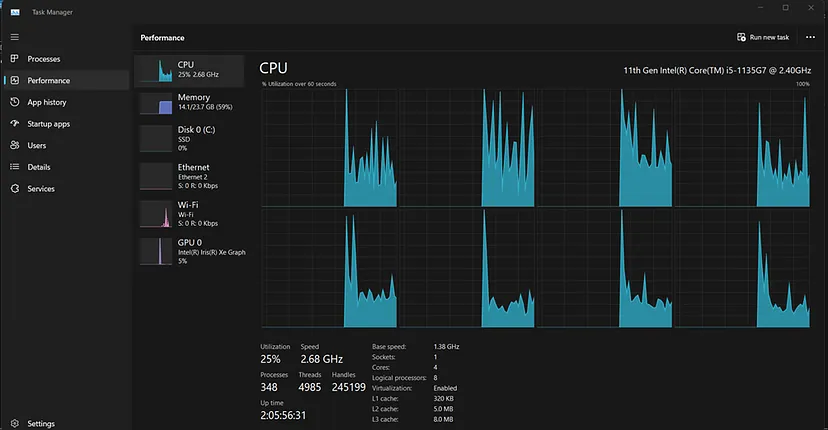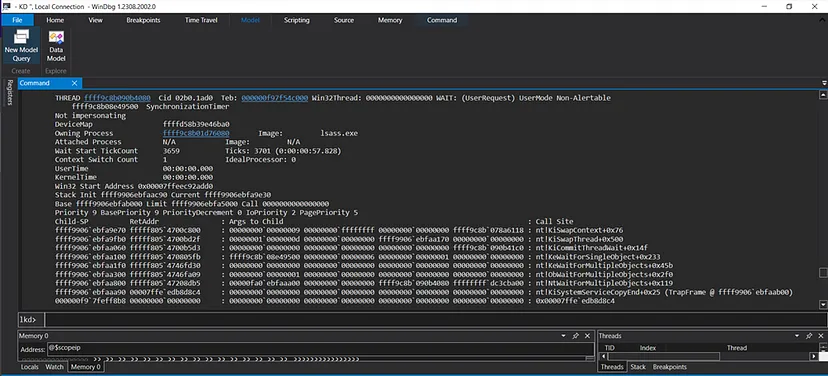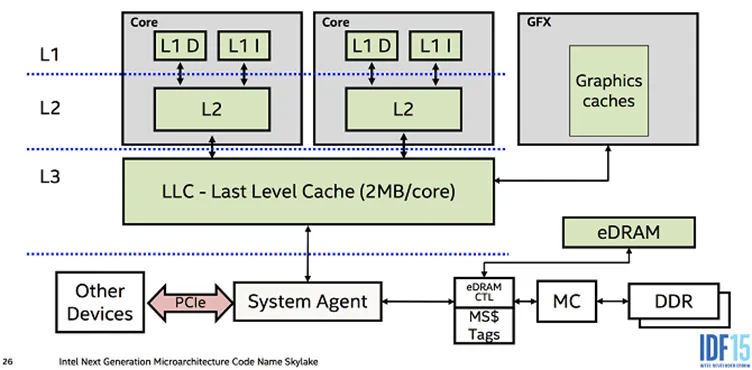Mysteries of the Windows Kernel Pt.2 - Thread Scheduling & CPU Internals
Understanding Threads and CPU Scheduling
In this article, we’ll explore what a thread is, its components, how threads relate to the CPU, and how they are scheduled when running on CPU cores.
What is a Thread?
A thread is a unit of execution that operates under a certain process. It is considered a Dispatcher Kernel Object (also known as a “Waitable Object”, which we’ll explore in depth later).
A thread primarily consists of the following components:
Access Token: Can be inherited from the process or impersonate another user’s token.
Priority: Includes Base Priority and Dynamic Priority (explained later).
Context: Also explained later.
State: Could be one of the following - Waiting, Running, Ready, Standby.
Affinity
To understand each of these components more in depth, let’s understand the main components of the CPU:
In the image above, the right architecture represents the concept of Hyper-Threading.
Understanding CPU Components
The CPU resides on a socket, a component within the motherboard. The CPU is primarily composed of cores, each of which is a unit of execution. Initially, each core was a single execution unit. However, with advancements in technology, Intel developed Hyper-Threading.
“Hyper Threading” is a technology that was developed by intel and allows a single core to be divided into 2 execution units, each called a “Logical Processor” (also known as “Hardware Threads”). In the image above, the architecture shown on the right displays the idea of “Hyper Threading”.
If we open Task Manager and navigate to the Performance tab, the CPU section shows graphs for each Logical Processor.
At the bottom, it lists:
- Number of Sockets (e.g., 1 in this case)
- Number of CPU cores (e.g., 4 cores)
- Number of Logical Processors (e.g., 8 Logical Processors, indicating Hyper-Threading support)
The more Logical Processors available, the more threads can be in the Running state simultaneously.
Thread States
Each thread has 3 primary states:
Running: The thread is actively executing within a Logical Processor.
Ready: A state where a thread is ready to be executed within one of the “Logical Processors”, but at this point and time it’s not in a high priority or the “Quantum” of the other thread that has the same priority didn’t finish yet. I’ll explain what a “Quantum” is soon.
Waiting: The thread is waiting for a signal from a Dispatcher Kernel Object (or Waitable Object). A “Dispatcher Kernel Object”, also called a “Waitable Object” is an object in which a thread can be in a “Waiting State” for until a signal receives from another object. For example, a thread can halt it’s execution and be in a “Waiting” state until another “thread” (which is a “Waitable Kernel Object”) signals. The meaning of a signal changes between different kernel objects
Thread Prioritization
The Kernel Scheduler in Windows prioritizes threads using 2 key components:
Base Priority: Determined by the process’s Priority Class (modifiable via the
SetPriorityClass()WinAPI function).Dynamic Priority: Adjusted dynamically at runtime.
Priority Classes and Base Priority
- Priority 0: Reserved for the Zero Page Thread.
- Low: Priority 4
- Below Normal: Priority 6
- Normal: Priority 8
- Above Normal: Priority 10
- High: Priority 13
- Real Time: Priority 24
Dynamic Priority Adjustments
- Idle: Priority set to 1.
- Lowest: 2 levels below the Base Priority.
- Below Normal: 1 level below the Base Priority.
- Normal: Matches the Base Priority.
- Above Normal: 1 level above the Base Priority.
- Highest: 2 levels above the Base Priority.
- Time Critical: Raised to Priority 31 (highest).
Using tools like Process Explorer, we can view very interesting information, such as:
- Thread’s state (Waiting, Running, Ready)
- Wait Reason — Relevant for threads that are in the “Waiting” state, it gives a brief description for what the thread is in a “Waiting” state for.
- TID — Thread ID.
- CPU Time — Time of execution within the CPU.
- Base Pri — The “Base Priority” of the thread.
- Dyn Pri — The “Dynamic Priority” of the thread.
Single-Core Scheduling
On single-core systems, threads in the Ready state are organized in a Ready Queue and prioritized. The highest-priority thread gets execution time.
But what happens if there are multiple threads in the same priority and wants to execute? But there is only 1 processor available on the CPU? Here’s where things get interesting.
Managing Equal-Priority Threads
In a case where there are multiple threads that have the same priority on a single-core CPU, then each thread receives a slice of execution time, called a Quantum. On client machines, the Quantum is typically 31ms (2 slices of 15.625ms).
Reasons for Context Switching
Threads stop execution and undergo a Context Switch in 3 scenarios:
The thread’s Quantum expires.
A higher-priority thread becomes Ready.
The thread enters a Waiting state (e.g., waiting for a signal).
Viewing Thread Information in WinDbg
Using the command !process 0 7 lsass.exe in WinDbg reveals detailed information about threads in the lsass.exe process:
Key details include:
THREAD ffff9c8b090b4080: Address of the thread’s ETHREAD structure.
WAIT: Current state (e.g., Waiting) and the object it waits on.
Context Switch Count: Number of context switches since thread creation.
Priority: Current Dynamic Priority.
Base Priority: The thread’s Base Priority.
UserTime: Execution time in User Mode.
KernelTime: Execution time in Kernel Mode.
Multiprocessor Scheduling
Affinity
Each process has an attribute called Affinity mask. Affinity is a 64-bit mask value defining the Logical Processors the process can execute on:
Soft Affinity: Default, allowing execution on all Logical Processors.
Hard Affinity: Restricts execution to specific Logical Processors (rarely used).
To view the “Affinity” of a process within “Process Explorer”, open “Process Explorer”, right click on some process and click on “Set Affinity”:
We can see that we have a list of a total of 64 “Logical Processors” (only 19 are marked and relevant in this case because this was captured on a system that has 19 LPs (“Logical Processors”)), and we can see that the process is allowed to run on all of the LPs available on the system, which means it’s Affinity is a “Soft Affinity”.
For a system that has more than 64 processors, each 64 LPs on the system are divided into groups and to express that, there is another attribute appended in the “Affinity” which is called “Processor Group”. For example, on a system that has 200 LPs, the first 64 LPs are related to “Processor Group 0”, the second 64 LPs are related to “Processor Group 1”, the third 64 LPs are related to “Processor Group 3”, and the remaining LPs are related to “Processor Group 4”.
To interact with Affinity, we can use the WINAPI functions such as:
SetThreadAffinityMask()SetProcessAffintyMask()GetProcessAffinityMask()
Ideal Processor
Another attribute which is important for multiprocessor thread scheduling is “Ideal Processor”.
“Ideal Processor” is a field that each thread has and it refers to a processor in which the thread’s execution would be ideal. The concept of ideal processor is one of the criterias that the scheduler takes into consideration when performing multiprocessor scheduling.
CPU Caching
To optimize execution and reduce RAM interactions, CPUs utilize 3 cache levels:
- L1 Cache
- L2 Cache
- L3 Cache
The idea behind these caches is to try to minimize interaction with the RAM during execution in order to optimize and increase execution speed at processing time.
L1 Cache — The smallest and fastest cache that each core has. It’s divided into 2 types of caching slots within it: Instruction Cache (I Cache), Data Cache (D Cache)
L2 Cache — A bigger cache but slower, every core has 1 L2 cache. This means that if a core supports “Hyper-Threading” and has 2 LPs within, the 2 LPs within the core will share the same L2 cache.
L3 Cache — The biggest and slowest cache. There is only 1 L3 Cache within the CPU and it’s being shared by all of the cores within the CPU.
Before getting to the idea of “Multiprocessor scheduling” I have to mention that the multiprocessor scheduling scheme is a base scheme and doesn’t include the idea of “Asymmetric Multiprocessing”, which may change the scheduling scheme and make it a bit more complicated.
The idea of “Asymmetric Multiprocessing” is that not all the cores within the CPU are being treated equally and some of the processors might be used for a specific purposes.
After having that out of the way, let’s see how multiprocessor scheduling works on “Symmetric Multiprocessing”.
First, the “scheduler” will first check if there is any “Logical Processor” available on the system. If there is, the following checks will be performed by order:
The first check will be if the “Logical Processor” in which the thread was previously running on is available, the reason for that is because there might be some cache related to the thread. If so, the “scheduler” will assign the “Logical Processor” to the thread.
The second check is if the “Ideal Processor” that is assigned to the thread is available. If so, the “scheduler” will assign the “Logical Processor” to the thread.
If both of the checks weren’t available, the “scheduler” will find the first available “Logical Processor” and run on it.
If there isn’t any “Logical Processor” that’s available on the CPU, the “scheduler” will check to see if there is any “Logical Processor” that runs a thread with a lower priority, if so, a “Context Switch” will occur, and the “Logical Processor” will be assigned to the thread. If not, the thread will continue to reside in a “Ready Queue” and wait until one of the scheduling conditions will match.
in the next article I’ll touch more about the “Memory Manager” component of the kernel, interaction between “Virtual Memory” and “Physical Memory” and how the “Memory Manager” manages memory within the system.





